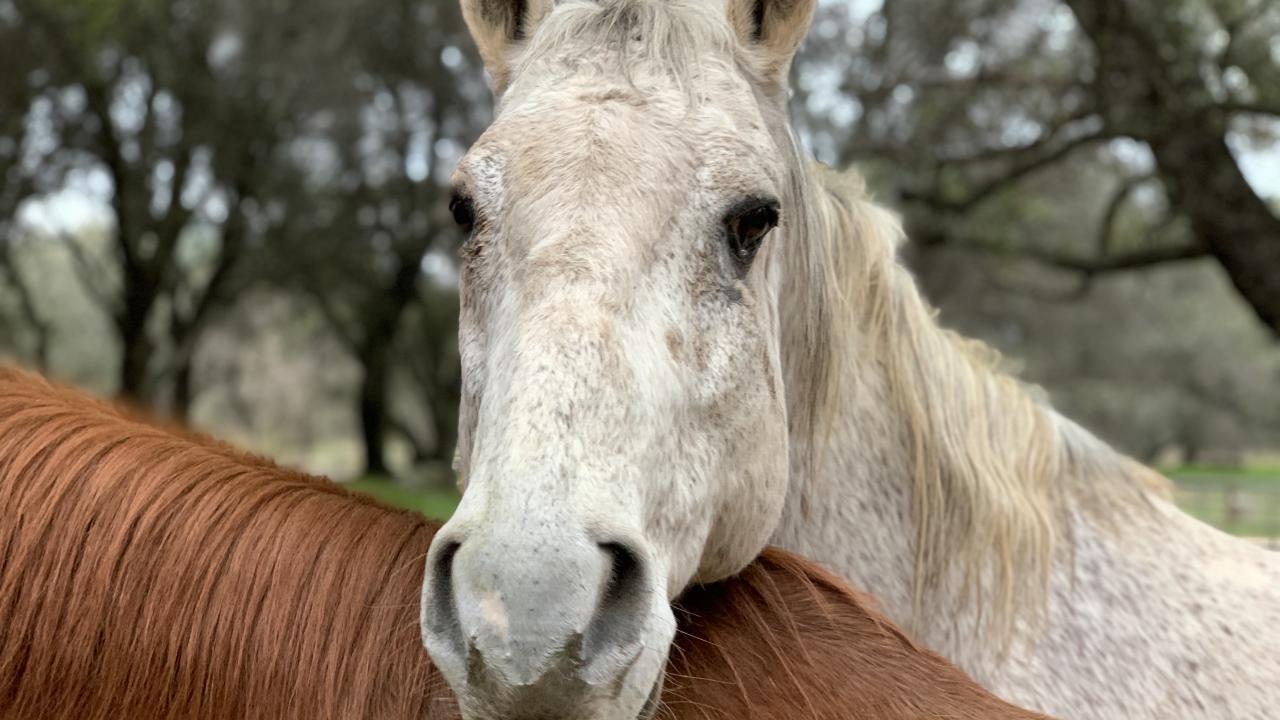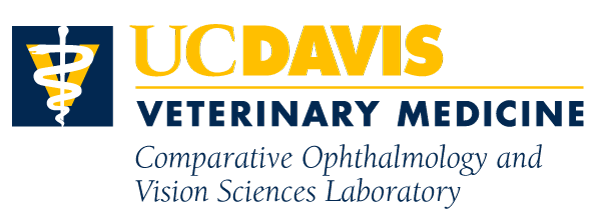
THREE EQUINE SPECIALTIES (AND A DEDICATED FAMILY) COME TOGETHER TO HEAL HORSE
“Case of the Month” – April 2020
Cooper, a 16-year-old quarter horse gelding, was brought to the UC Davis veterinary hospital after his owner, Robyn Armstrong, noticed spooking behavior over the past few months. Her normally friendly horse was not letting her near him. The hospital’s ophthalmologists noticed an obstruction in Cooper’s vision, but also noticed an unrelated abnormality on his face. The two separate conditions initially concerned Armstrong and set Cooper back a few months, but ultimately, he emerged a much healthier, happier horse.
Board-certified ophthalmologist Dr. Sara Thomasy and resident Dr. Elyse Salpeter concurred with Cooper’s referring veterinarian’s diagnosis that his corpora nigra was the culprit of his odd behavior. The corpora nigra is a formation on the top of a horse’s pupil that shades its eyes from excessive glare. Sometimes, it can enlarge and become cystic, causing it to interfere with the horse’s vision or spook it. In Cooper’s case, the corpora nigra was dangling in front of the pupil, obstructing vision. Dr. Thomasy scheduled Cooper for a sedated procedure using laser ablation to contract the enlarged corpora nigra out of his pupil.
During Cooper’s examination, the team also noticed a foul odor emitting from two fistulas present at the maxillary sinus – the area just below his eye. Armstrong noted their presence since she adopted him two years ago, and though she continuously flushed them out, the odor persisted. The rescue organization had the site surgically corrected previously, only to have it fail, so Armstrong didn’t think there was any hope to fix it.
Dr. Thomasy recommended Cooper be examined by the Equine Dentistry and Oral Surgery Service while sedated for the ablation procedure. Drs. Nicola Pusterla and Colleen Heney examined Cooper’s facial deformity. Sinus and dental radiographs showed abnormalities of his facial bones and sinuses, most likely from a past trauma. A large amount of pus (the source of the odor and consistent with an infection) was observed, as well as haired skin that had infiltrated his sinus cavity – this needed to be surgically removed to resolve his infection.
Dr. Colleen Heney was joined by members of the equine surgery team—faculty clinician Dr. Scott Katzman and intern Dr. Mark Hall—who were brought in to perform the procedure. The team was able to flush abnormal material from the sinus with endoscopy and remove the haired skin within the sinus surgically. Sutures were used to close the wound, but Armstrong was concerned about their failure less than a week later at home.
Through photos and email, the care team was able to communicate with Armstrong and Cooper’s referring veterinarian, UC Davis alum Dr. Corey Harms (DVM ’16) of Sierra Equine Veterinary Services. This communication prevented Armstrong from having to make another 2-hour journey to UC Davis. Dr. Heney even worked with the pharmacy to have Cooper’s medications mailed to Armstrong. Dr. Katzman recommended patience to see how the wound would heal with time, even though the sutures were not ideal.
“I was very worried initially,” said Armstrong. But she held out hope and trusted the team.
Throughout the recovery, Armstrong administered antibiotics to Cooper to prevent the surgical site from becoming infected. This required her to drive 30 minutes each way, twice a day for eight weeks, to Cooper’s boarding facility. Thankfully, she had the support of her sister Buzzy Labrenz, who assisted in all the responsibilities and the medication duties.
At the boarding facility, Cooper lives with his “brother” Kennedy, a 25-year-old quarter horse named for the president after Armstrong adopted him on President’s Day weekend four years ago. Armstrong calls Kennedy the epitome of the slogan “healthy as a horse,” and says he has been a great companion for Cooper. She often rides them on the boarding facility’s trail system around the Yuba River.
With continued stall rest, antibiotics, the use of an equivizor, and tremendous dedication from Armstrong and Labrenz, Cooper made a full recovery. His wound completely healed just as Dr. Katzman had hoped.
“The surgery ended up being a great success,” said Armstrong. “I felt like a kid on Christmas morning when I removed the equivizor to see Cooper’s healthy face. And now, I am so beyond thrilled and happy. I am indebted to the entire team who contributed to Cooper’s improved behavior and helped heal his injuries.”
Procedures like Cooper’s—collaborations amongst multiple specialists, and robust training opportunities for residents and students—are UC Davis’ focus when envisioning its future Equine Performance Center and Equine Surgery and Critical Care Center as part of the Veterinary Medical Center (VMC) campaign. This multi-phased project to construct an entirely new veterinary hospital on campus is already underway. When complete, the VMC will boldly change the face of veterinary medicine at UC Davis, becoming the foremost animal care facility in the world.
To see more photos of Cooper – Click here
